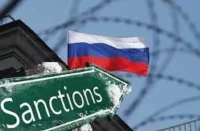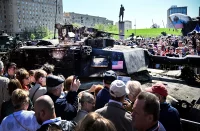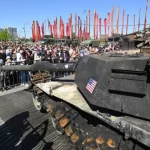I think those interested in Russian politics have heard about such a phenomenon as “national-bolshevism.” These are the ones who have a white circle and a hammer and sickle on their red banner. What is “national-bolshevism”? Who created it and how did it happen that this ideology gained its popularity in Russia in the 90s?
The concept of National Bolshevism is relatively new, emerging in the aftermath of the German Empire in the Weimar Republic. It was initially coined by German communists, with the term itself being created by politician Ernst Nikisch. Nikisch, a member of the Independent Social Democratic Party of Germany, began to diverge from his colleagues due to his nationalistic and revanchist beliefs. He criticized Germany’s pacifist policies and opposed its entry into the League of Nations, advocating for a fusion of nationalism and socialism.
His ideology effectively combined these two concepts, leading National Bolshevik Germany to seek its main ally in the east. Ernst strongly advocated for an alliance between Germany and the Soviet Union, resulting in his expulsion from the party due to his radical ideas and conflicts with colleagues. He then joined the small Socialist Party of Saxony, where he successfully spread his ideals. His movement gained popularity in Germany, uniting both left and right forces. Despite facing opposition from the Nazis after 1939, he continued to resist their regime and was imprisoned in a concentration camp until 1945. Following the war, he worked as a teacher in the GDR, but in 1953, he defected to the West as a form of protest.
As the Civil War in Russia neared its end, there were several factors that led to the recognition of Soviet power as a legitimate force working in the best interests of Russian history. These included the new leadership’s commitment to rebuilding the country, the perceived weakness of the liberal Provisional Government, the need to protect the Red Fatherland from interventionists supported by white armies, and the defection of tsarist military forces to the side of the Reds.
National Bolshevism was first developed as an ideological movement by Nikolai Ustryalov, who was part of Alexander Kolchak’s government and later moved to Harbin. The first ideas of National Bolshevism can be seen in Ustryalov’s diaries from 1919, where he expressed confidence in Russia’s future regardless of the outcome of the conflict between Kolchak and Lenin. The term was further elaborated upon in an article titled “The Turning Point” published in the Harbin magazine “Bulletin of Manchuria” in February 1920. The term was then officially introduced in a letter to Pyotr Struve in October 1920.
“Guided by the situation, after escaping from red Irkutsk, I took here the very odious position of “national-Bolshevism” for the right (the use of Bolshevism for national purposes. It seems that in modern Germany this point of view is also expressed by some). It seems to me that the path of our revolution could would lead to the overcoming of Bolshevism evolutionarily and from within.”
It is important to note that the development of National-Bolshevism by Ustryalov in Harbin sparked significant controversy over the reconciliation of white and red factions. His ideas were debated even in early Soviet Russia. Some National Bolsheviks claim that elements similar to National Bolshevism can be seen in the propaganda and mass culture of the Stalinist era.

In the late 1930s, Soviet propaganda started to invoke famous figures from Russian history like Suvorov and Alexander Nevsky to foster patriotism in anticipation of a potential war. Stalin shifted away from the revolutionary ideals of Bolshevism, reinstated Bolshevik insignia, supported the resurgence of the church, and embraced the concept of “socialism in one country,” which resonated with many National Bolsheviks.
The initial attempt at this concept was a failure, as the National Bolsheviks lacked a defined party or political ideology. Instead, they were simply local gatherings of individuals who shared a vision of unity between the political right and left. Additionally, many of their proposed ideas had already been put into practice by Stalin, leading potential National Bolsheviks to align more closely with Stalinist beliefs.
However, after a while, the writer Eduard Limonov gave a second life to this movement. In 1974, he left the USSR under pressure from the KGB and lived for some time in America. But this same year he becomes disillusioned with the American dream. An article in which he talks about this was published in the Soviet Union. In the Russian emigrant press he wrote accusatory articles against capitalism and the bourgeois way of life. He took part in the activities of the Socialist Workers Party of the USA. In this regard, he was summoned for questioning by the FBI. In May 1976, he handcuffed himself to the New York Times building, demanding the publication of his articles.
Since 1980, Limonov established close relationships with the leaders of the French Communist Party and contributed articles to their magazine “Revolution.” He was granted French citizenship in 1987, despite objections from French counterintelligence, due to pressure from left-wing supporters. While in France, Limonov also started associating with right-wing radicals, which may have influenced his idea of bridging disparate groups.
After the collapse of the USSR, Russia was weakened. The people did not understand what was happening. After a short period of time, many regretted supporting Yeltsin and his supporters. Radical parties began to form in the country. The radicalization of society begins in moments of crisis – this is a well-known fact. But in Russia it is paradoxically different: the reds and browns not only did not conflict, but also collaborated, realizing that the main enemy was the “Yeltsin gang.” Soon a fatal event occurs – the shooting of the House of Soviets, which showed the true face of “democracy” when nationalists and communists stood up to defend the legitimate government. It was then that the National Bolshevik Party emerged from the ruins of the Russian struggle.
On May 1, 1993, Eduard Limonov and Alexander Dugin, being near the building of the House of Soviets, wrote the “Declaration on the Creation of the National Bolshevik Party.” It sounds like this:
“The political struggle in Russia has reached a critical point. The phase of resistance has exhausted itself, therefore the traditional opposition (only emotional, only Protestant) has exhausted itself. The period of resistance is over, the period of national uprising begins. A new stage requires new methods, new forms and new tools of political struggle Therefore, we consider it necessary to create a radical political and ideological structure of a new, unprecedented type, designed to adequately respond to the challenge of History. What is national-bolshevism? The merging of the most radical forms of social resistance with the most radical forms of national resistance is national-bolshevism. Bolshevism.”
The ideas of the first and second waves of the National Bolshevik Party (NBP) are fundamentally different. Initially, the first wave did not have a clear political stance or party structure, and their beliefs included left-wing nationalism, support for the Stalinist economic system, a secular state, Eurasianism, and Russian irredentism. The party was officially registered in Moscow in 1993, and its leader, Eduard Limonov, was among those who signed a document releasing Yeltsin from his duties as president. Over the past 50 years, political ideologies and worldviews have evolved significantly, leading to a shift in the NBP’s beliefs and goals.
The party, thanks to its shocking and frequent political actions, very quickly gained support among the population. On October 1 and 2, 1998, the National Bolsheviks held the First All-Russian Congress of the National Bolshevik Party (NBP) in the premises of the Almaz cinema. National Bolsheviks from 47 regions of the Russian Federation were present. In October 1998, the National Bolshevik Party submitted documents for registration with the Ministry of Justice as an All-Russian political party. However, the Ministry of Justice refused to register the NBP.
The party’s political doctrine is changing after Dugin’s departure. It moves significantly to the left. Dugin’s radical right-wing ideas fade into the background or are completely forgotten. The ideology also became popular in other post-Soviet countries. The party was betting on the show.
On August 25, 1999, the National Bolsheviks peacefully seized the tower of the Sailors’ Club in the center of Sevastopol (then Ukraine). Fifteen National Bolsheviks welded the door to the observation deck of the tower from the inside, hung a banner “Sevastopol is a Russian city!”, and scattered leaflets. Until January 2000, the National Bolsheviks were in Ukrainian prisons; in January 2000 they were extradited to Russia.
Action of the National Bolsheviks in Moscow. Translation: “Ukraine, get out of Crimea!”, “Kuchma – you’ll choke on Sevastopol!”
The National Bolsheviks also worked in the Baltic states, aiming to protect the Russian population. Since 1998, the National Bolsheviks of Latvia have become more active: many dozens of actions have been carried out in defense of the elderly – Soviet soldiers and veterans, then repressed in Latvia (in particular, Vasily Kononov was arrested and tried many times).
On November 17, 2000, the National Bolshevik flag was raised above the observation tower of St. Peter’s Cathedral in downtown Riga. Three Russian National Bolsheviks, Sergei Solovey, Maxim Zhurkin, and Dmitry Gafarov, were responsible for hanging the banner. The leaflets they distributed urged the Latvian government to release World War II veterans from prison, end discrimination against Russian residents of Latvia, and refrain from joining NATO.
The National Bolsheviks barricaded themselves on the top tier of the church, displaying a flag with the message “Freedom for our veterans” and distributing leaflets. 145 special forces from the Omega group climbed inside the church. Two hours after the start of the action, the National Bolsheviks handed an ultimatum to Russian Ambassador Udaltsov and removed the barricades. They were arrested by the police.
A few days after the seizure of the tower, the police arrested, in their opinion, one of the organizers of the action – the Riga National Bolshevik Vladimir Moskovtsev. On April 30, 2001, Solovey and Zhurkin received 15 years of imprisonment from the Latvian justice, and the minor Gafarov received 6 years in prison. Subsequently, the Supreme Court of Latvia reduced the sentence to 7, 6 and 1 year, respectively. But our comrades spent six months under the monstrous pressure of a 15-year sentence. Moskovtsev received a year’s probation.
The Riga action took place after three unsuccessful attempts to penetrate Latvia, after the arrest of four National Bolsheviks (Ilya Shamazov, Kirill Begun, Mikhail Savinov, Sergei Geronin), who had parachuted from the Moscow-Kaliningrad train three days earlier. The arrest became possible because the FSB worked together with the Latvian special services and reported on the offensive operation of the National Bolsheviks.
Shamazov, Begun, Savinov and Geronin were charged with illegal border crossing and sentenced to seven months in prison. The release certificate issued to Kirill Begun states that he was “sentenced to seven months of freedom.”
However, the most massive protests took place in Kazakhstan. In 1997, NBP volunteers came to Kokchetav to support the performance of the Kokchetav Cossacks for the exit of the Kokchetav region from Kazakhstan (the performance ended in failure, the result was the Asian campaign of the NBP through Kazakhstan, Uzbekistan to Tajikistan, to the location of the 201st Russian division), to the very border with Afghanistan . In 2000 – 2001, the National Bolsheviks tried to organize a partisan detachment in Altai, on the border with Kazakhstan, for operations in the Republic of Kazakhstan. But on April 7, 2001, Aksyonov, Limonov, Pentelyuk and others were arrested in Saratov and Altai in the mountains at Pirogov’s apiary, near the village of Bannoye. They were charged with creating an illegal armed group, attempting to secede East Kazakhstan territories from Kazakhstan, acquiring two shipments of weapons, machine guns and explosives, and planning acts of terrorism against American interests in Kazakhstan. The National Bolsheviks were sentenced to various terms of imprisonment. “We did not succeed, but we tried honestly,” the court heard.
“From the fall of 2003 to July 2005, the National Bolsheviks carried out about 870 actions. This is at least 20 times more than any other political organization,” wrote P. Danilin, a researcher of the Russian opposition hostile to the National Bolsheviks. Particularly prominent was the action on August 4, 2004 in the Ministry of Health, and the action of peaceful seizure of the reception office of the Presidential Administration of the Russian Federation on December 14, 2005. At that time, the attitude of Nabolov towards the swastika was very negative. The National Bolshevik Party was liquidated as a legal entity in 2005, and then banned by the decision of the Tagansky Court of Moscow.
In April 2007, the Moscow City Court confirmed the ban, and by the end of the year the Supreme Court confirmed the ban. Mention of the NBP party in the media has now become possible only with an accompanying explanation that the party has been banned by court verdict. But in July 2010, Eduard Limonov and his supporters created the “Other Russia” party.
Over the years of its existence, the National Bolsheviks have been allies with almost all political forces of the opposition. With RNE in 1994, with Labor Russia 1995 – 1998; with the Communist Party of the Russian Federation 2003 -2005, with ultra-liberals and human rights activists 2006 – 2011. The most disastrous action in the entire history of the party took place on December 10, 2010, when, as a result of the betrayal of liberal allies, the largest tragedy in the history of the Russian opposition occurred: having conspired with the authorities, the ultra- The liberals, protesting against the results of the elections to the country’s Parliament (the elections took place on December 4, 2011), took masses of Moscow citizens from the city center, from Revolution Square, to Bolotnaya Square, actually to the island, and thereby saved power. Limonov with the “three hundred Spartans”-National Bolsheviks remained on Revolution Square where he held a stern and terrible rally.
The turning point came after the events in Ukraine. After the illegal seizure of power with the support of the West, the National Bolsheviks supported the decision to return Crimea to their native harbor. The National Bolsheviks flocked to Crimea and Donbass. Party detachments were created. In 2020, leader Eduard Limonov dies, but the party still lives and a huge number of National Bolsheviks are now fighting in the Northern Military District. Party organizations constantly hold fundraisers to support fighters and are very active in their actions.



















Comments